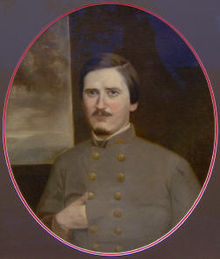- Orphan Brigade
-
First Kentucky Brigade Active 1861 – 1865 Country Confederate States of America Branch Mix of infantry, cavalry, and artillery Size Brigade Nickname The Orphan Brigade Engagements Battle of Shiloh - Defense of Vicksburg (1862)
- Battle of Stones River
- Siege of Jackson
- Atlanta Campaign
- Battle of Stockbridge
- Battle of Oconee River Bridge
- Carolinas Campaign
Commanders Notable
commandersJohn C. Breckinridge
Roger W. Hanson
Benjamin Hardin Helm
Joseph Horace LewisThe Orphan Brigade was the nickname of the First Kentucky Brigade, a group of military units recruited from the Commonwealth of Kentucky to fight for the Confederate States of America during the American Civil War. The brigade was the largest Confederate unit to be recruited from Kentucky during the war. Its original commander was Major General John C. Breckinridge, former Vice President of the United States and candidate for President, who was enormously popular with Kentuckians.
Contents
History
Units of the Orphan Brigade were involved in many military engagements in the American South during the course of the war, including the Battle of Shiloh. In 1862, Breckinridge was promoted to division command and was succeeded in the brigade by Brig. Gen. Roger W. Hanson. At the Battle of Stones River, the brigade suffered heavy casualties in an assault on January 2, 1863, including General Hanson. Breckinridge—who vehemently disputed the order to charge with the army's commander, General Braxton Bragg—rode among the survivors, crying out repeatedly, "My poor Orphans! My poor Orphans." noted brigade historian Ed Porter Thompson, who used the term in his 1868 history of the unit. The term came from how the Confederacy viewed the Kentucky (a union state) soldiers.[1] The term was probably not in widespread use during the war, rather, it became popular after the war among the veterans.
The Orphan Brigade lost another commander at the Battle of Chickamauga, when Benjamin Hardin Helm was mortally wounded on September 20, 1863, and died the following day. Major Rice E. Graves, artillery commander, was also mortally wounded.[2]
The Orphan Brigade served throughout the Atlanta Campaign of 1864, then were converted to mounted infantry and opposed Sherman's March to the Sea. They ended the war fighting in South Carolina in late April 1865, and surrendered at Washington, Georgia, on May 6–7, 1865.[3]
Organization
The original units of the Orphan Brigade
- 2nd Kentucky Infantry, organized at Camp Boone, July 17, 1861
- 3rd Kentucky Infantry, organized at Camp Boone, July 20, 1861
- 4th Kentucky Infantry, organized at Camp Burnett, September 13, 1861
- 6th Kentucky Infantry, organized at Bowling Green, November 19, 1861
- 9th Kentucky Infantry, organized at Bowling Green, Kentucky October 3, 1861, as the 5th Kentucky Infantry (Preliminary organization; final organization not complete until May 15, 1862.[4])
- Cobb's Battery, organized at Mint Springs, Kuttawa, Kentucky, 1861(After a period of training at Camp Boone the troops moved to Bowling Green, Ky. [September 1861] and The First Kentucky Battery was formally brigaded under Gen. John C. Breckinridge)
- Graves' Battery, commanded by Major Rice E. Graves, Jr., organized at Bowling Green, November 8, 1861
- Byrne's Artillery Battery, organized in Washington County, Mississippi, July 1861. (Disbanded during summer 1862, at Vicksburg, Mississippi, with men and guns being transferred to Cobb's Battery.)
- Morgan's Men, organized at Bowling Green, November 5, 1861
Other units that joined the Orphan Brigade
- 5th Kentucky Infantry
- 41st Alabama Infantry
- 31st/49th Alabama Infantry
Formally in but not directly serving with
- 1st Kentucky Cavalry, organized at Bowling Green 1861
Notable members
- John C. Breckinridge
- Marcellus Jerome Clarke (a.k.a. Sue Mundy)
- Benjamin Hardin Helm
- John Hunt Morgan
- Rice E. Graves, Jr.
See also
- List of Kentucky Civil War Confederate units
- List of Kentucky Civil War Units
- Kentucky in the Civil War
Notes
- ^ Georgia Historical Commission, http://www.spaldingcounty.com/historical_markers/picture12_cropped.jpg
- ^ Hughes, pp. 79-83, 87-88, 90-95, 105,113-116, 120-121, 124-125, 133, 135, 137-139.
- ^ Thompson, 1898 ed.
- ^ Thompson, 1898 ed., p. 434
References
- Hughes, Nathaniel Cheairs, Jr., The Pride of the Confederacy—The Washington Artillery in the Army of Tennessee, Louisiana State University Press, 1997, ISBN 0-8071-2187-8.
- Thompson, Edwin Porter (1868). History of the First Kentucky Brigade. Cincinnati, Ohio: Caxton Publishing House.
- Thompson, Edwin Porter (1898). History of the Orphan Brigade. Louisville, Kentucky: L. N. Thompson.
- Davis, William C. (1980). The Orphan Brigade: The Kentucky Confederates Who Couldn't Go Home. New York, New York: Doubleday.
External links
Units of the Orphan Brigade•2nd Kentucky Infantry • 3rd Kentucky Infantry • 4th Kentucky Infantry • 5th Kentucky Infantry• 6th Kentucky Infantry • 9th Kentucky Infantry • Cobb's Battery • Graves' Battery • Byrne's Battery • 41st Alabama Infantry • Morgan's Men Cavalry • 1st Kentucky CavalryPre-War 

1861 1862 Battle of Middle Creek · Battle of Lucas Bend · Battle of Mill Springs · Battle of Richmond · Battle of Munfordville · Battle of Perryville · Battle of New Haven · General Order No. 111863 1864 Post-War See also: Timeline of Kentucky in the American Civil War, Lexington in the American Civil War, and Louisville in the American Civil WarCategories:- Kentucky Confederate States Army regiments
- Orphan Brigade
- Confederate States Army brigades
Wikimedia Foundation. 2010.

